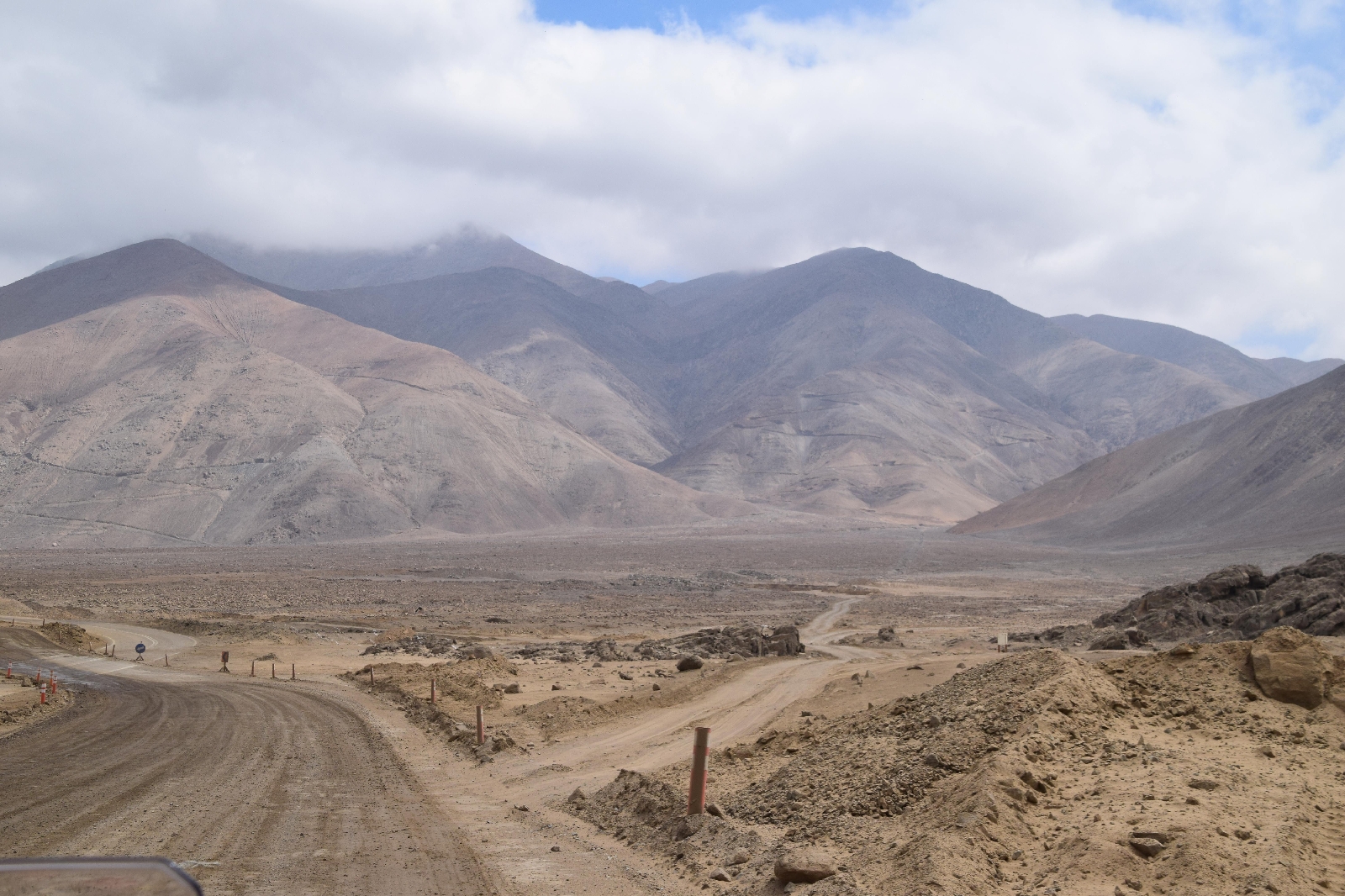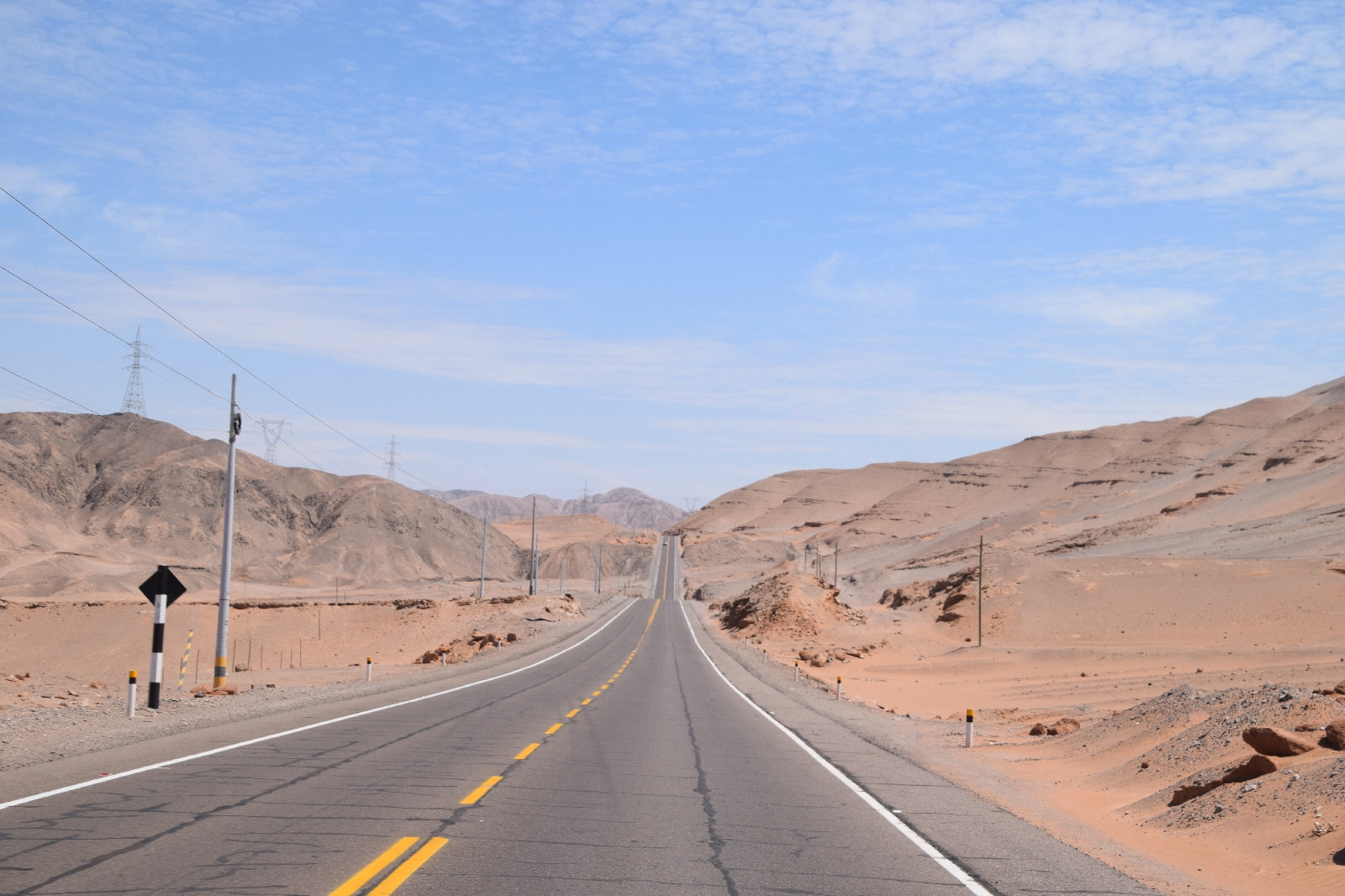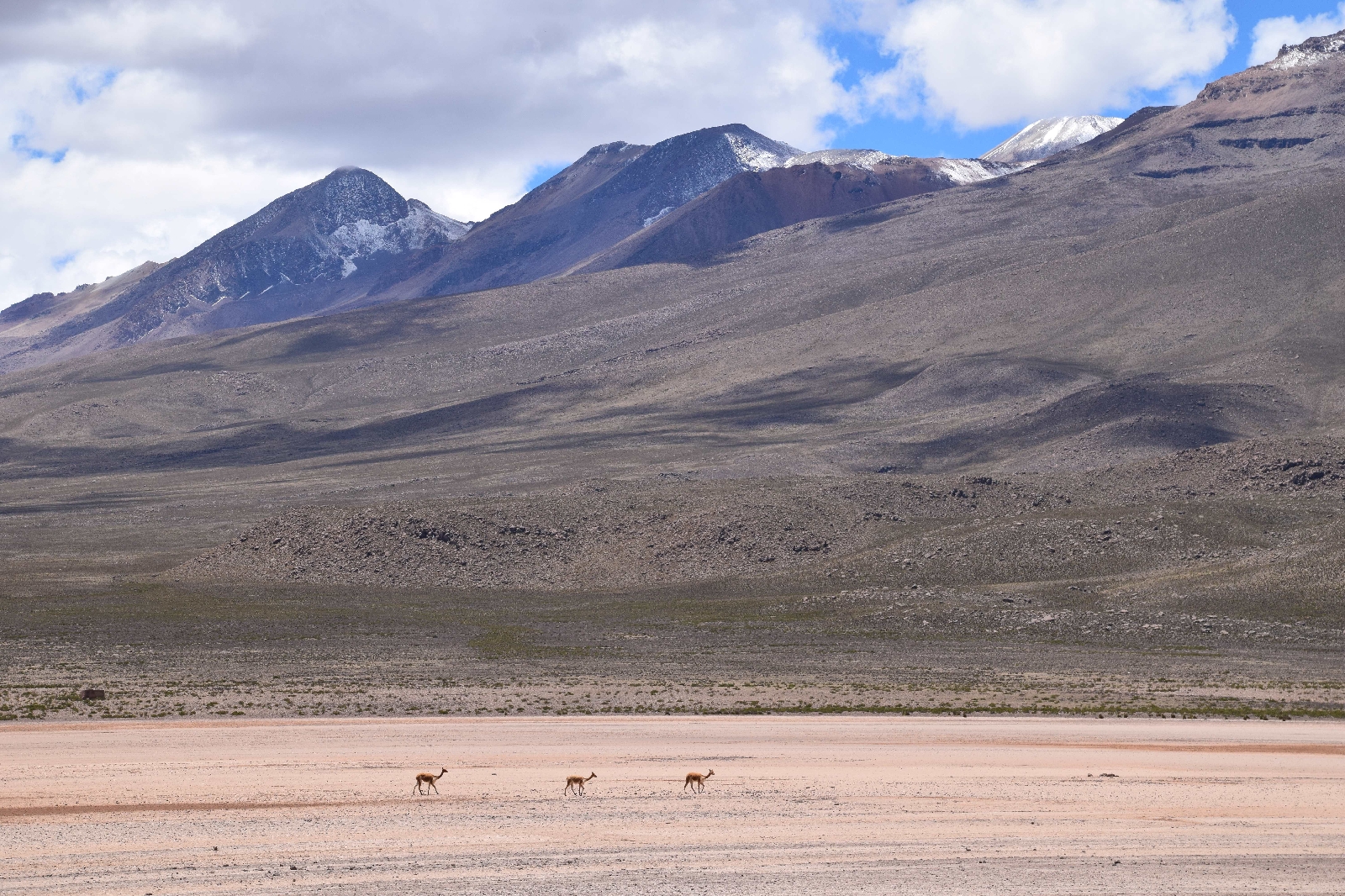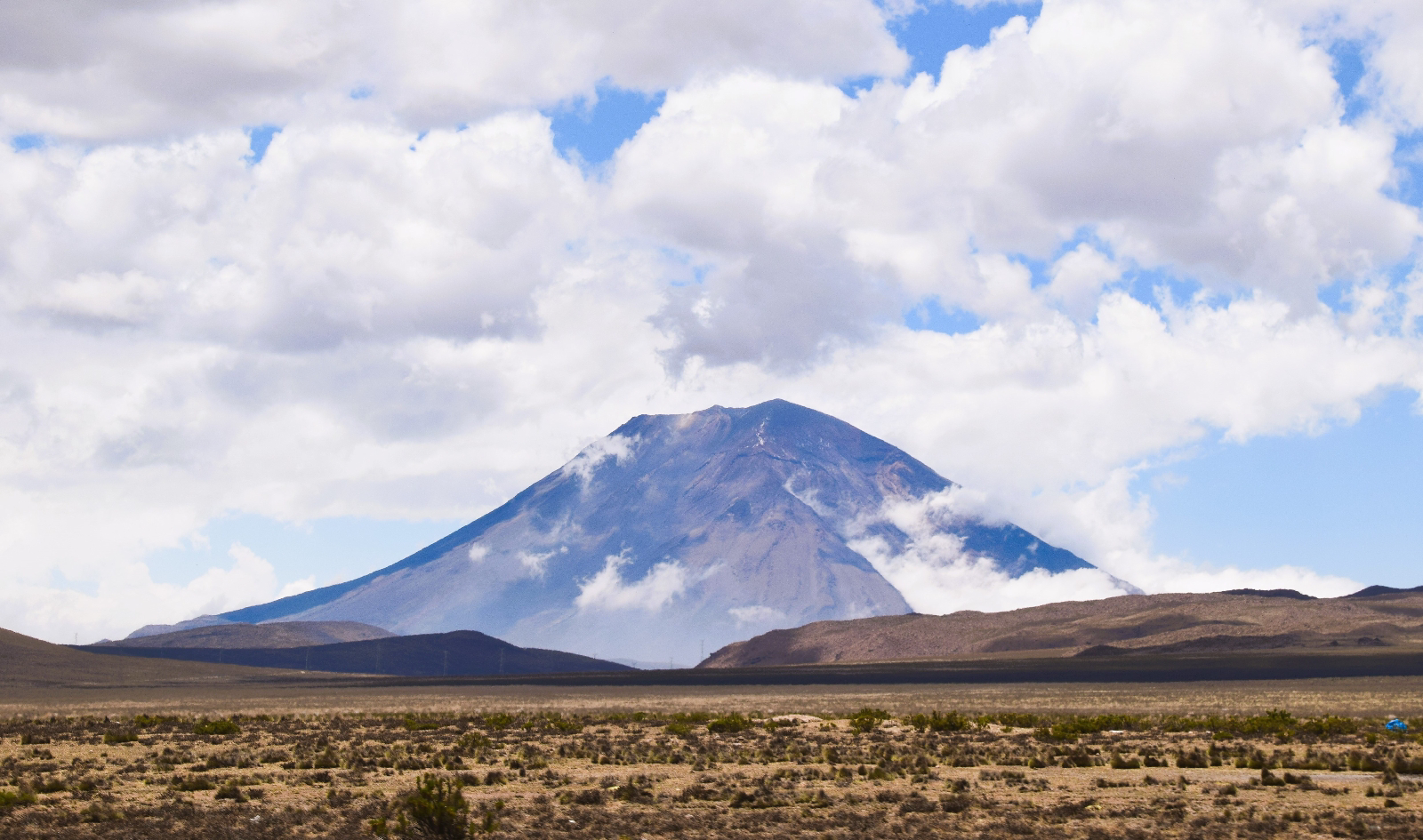But we needed to set off whether we were bleary-eyed or not. We had met a couple in the hostel we stayed at in Santiago and they invited us to dinner if we ẃere ever passing by Antofagasta. So we decided to go that way.
The road wasn't the most scenic but some parts were interesting. This is mining country. Not pithead and winding towers but moving mountains. We think the green stains on some of the mountains were copper.
This area was at the heart of the War of the Pacific at the end of the 19th Century. Bolivia had nitrate deposits. Chile didn't. But it was the Chileans who were working the mines. And then the Bolivians increased the taxes on the Chileans. So there was a war. And Peru was dragged in because they had a deal with Bolivia. Or something like that. Taking into account who was who at the end of the 19th Century, there was more than likely a UK role in this as far as ownership of the mines was concerned. Anyway Bolivia used to extend to the sea, which was very useful for shipping its minerals. Clearly they lost out to Chile as did Peru. Antofagasta where we were staying was Bolivian and has some Bolivian buildings still standing in the centre of town. What was the South of Peru is now the North of Chile. Of course mining is still big and Lithium is on the agenda now. And export routes are still needed.
Jose and Ximena showed us round Antofagasta and its equivalent of Durdle Door - there was also the ruins of a Bolivian silver smelter and warehouse facility and we only wished our Spanish was better...
From Antofagasta we went to Iquique which also changed hands. It was quite a spectacular ride up the coast. There were ramshackle settlements everywhere. We really don't understand how they work, electricity, water, sanitation, waste wise. They looked very ramshackle. Tin, timber and tarpaulin lean-to's with not much to lean against. But there were what looked like new cars parked next to them. We stopped for a lunch of seafood empanadas and lemonade and met a really jolly Brazilian couple, Bolivar and Celia, who were going the other way on their bike.
We had thought that Iquique would just be a stopover. But it turned out to be a really nice beach resort. We would have liked to stay longer but had planned on getting to Peru. Whenever there is a border crossing, we try whenever possible to stay either side of it. No point in getting to a border crossing late in the day, far better to get there earlyish in the morning. And it's also better to not have to go too far afterwards in case you are held up at the border. So we planned on stopping in Arica on the Chile side of the border and Tacna on the Peruvians side. Arica was another of the spoils of war. We have this preconception, based on experience we must say, that border towns can be pretty grim places, but both Arica and Tacna were great.
Our stop in Arica had great parking and Tacna was one of the most lively places at night we have come across on our travels. And it certainly had the best Christmas tree and Nativity.
We had forgotten about border crossings simply because generally the Argentinian/Chilean ones had been so painless. This one was slightly more onerous in that there were long queues. So it took us two and a half hours to clear the border, and that takes into account us using the motorbike to queue jump on a couple of times. Our luggage was also checked twice to no avail. We still have our coca for the high altitude bits of Peru! We also forgot the times may change at borders and we regained two of the two and a half hours we lost.
A strange thing we have seen on the road in Peru is vineyards in the desert with vines growing out of sand. We know the towns use water from desalination plants along the coast and maybe this is used for the vines too, Apparently Peruvian wine is a tad sweet. We haven't got to it yet, being a bit wary of altitude and alcohol. What is also strange is to come across oases. We stopped in one for lunch. Freshwater shrimp and rice - both from outside the window of the restaurant.
We are writing this bit from our stopover in Arequipa in Peru. It's quite chilly here but probably normal as we have moved up to 2,500m. Traffic on the roads in Peru is different. There are thousands of taxis in even the smallest of towns. The principal roads are dominated by very large, slow moving trucks, sometimes in convoy. The roads are single lane in either direction so it's quite difficult to proceed at a decent average speed. The motorbike does however help. Apparently there were things to see and do in Arequipa but we missed them.
We did come across a fatal accident about ten vehicles in front of us. A small bike and the rider was clearly dead. Not sure what happened. There was a large piece of wood in the road. Whether he hit or dropped it or it hit him we will never know. His helmet was some 10m away from the body as was one of his flipflops. What was shocking was the amount of people, stuck in the queues that quickly built up either side of the incident, that had gotten out of their cars and buses to go and have a look and get a selfie before somebody covered the body with a rug. The bike and body were strewn across the road but we could squeeze by. We weren't going to help the situation by staying there. We know we need to be careful, and we think we are being so, but this was nonetheless a reminder.
The following day was about getting to Puno on the shore of Lake Titicaca. There was a direct road from Tacna to Puno, but we weren't sure about the condition of a section of it and we spent an extra day going a longer way round. We keep telling ourselves that our adventure is about doing the trip and, hopefully, getting to somewhere that satisfies us as an 'end'. It's not about taking unnecessary risks along the way - something that was reinforced the other day. Getting out of Arequipa was very hard work indeed aswell as time consuming. It wasn't the taxis or lorries this time but the buses. The small white ones that ply a route but that seem to be able to stop wherever you want. Of course the lorries and taxis were also thrown into the mix resulting in us overheating and also a fear that the bike would do the same. The condition and narrow width of the road plus the mass of traffic in the opposite direction didn't permit overtaking. However we did manage to get some clear space eventually and spent the vast majority of the ride over 4,000m. We need to set off earlier next time we have a big ride and need to get out of a town.
We have often said that we prefer to have stopovers outside of big towns rather than within, but there is little choice of stopovers. Whereas finding accommodation is still a priority, petrol seems to be easier. However we were quite shocked by the price of petrol in Peru until we realised that they were displaying the price per gallon as opposed to per litre.



























